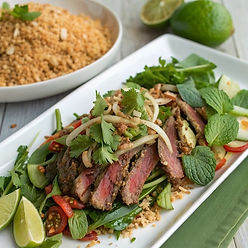Strategic Cutting Techniques for Better Dining Experience

The judge's constructive feedback that if the beef would have been cut smaller it would have been easier to eat identifies how cutting technique directly impacts dining experience regardless of how well other elements are executed. Large pieces of protein in salad context create practical eating challenges: forks struggle to spear and hold large slices requiring knife which disrupts casual salad eating, large pieces prevent balanced bites where each forkful contains proportional amounts of all components, and diners must either awkwardly eat large piece alone or attempt to tear or cut it with fork edge creating messy dining. Jet's waterfall salad featured properly cooked tender beef as judges acknowledged when noting it does eat nice and tender, but presentation in large slices rather than bite-sized pieces diminished enjoyment. The improved cutting technique requires two-step process: first slice beef against the grain (perpendicular to visible muscle fibers) into thin strips about 1/4-inch thick which shortens muscle fibers making meat more tender, then cut these strips crosswise into bite-sized pieces approximately 1-2 inches long creating pieces that fit comfortably on fork with other salad components. This cross-cutting transforms long strips into manageable rectangles perfect for salad context. The against-the-grain slicing is crucial because cutting parallel to fibers (with the grain) leaves long intact muscle fibers requiring more chewing and creating stringy texture, while cutting perpendicular severs fibers into short segments that feel tender and succulent. Testing grain direction involves looking at raw or cooked meat and identifying which direction the muscle fibers run (they appear as parallel lines), then positioning knife perpendicular to those lines so each slice cuts across maximum number of fibers. For competition or restaurant service, consider final eating context when determining cutting size: plated dishes where knife is provided can accommodate larger slices, family-style sharing where knife may be unavailable requires smaller pre-cut pieces, salads or grain bowls need bite-sized pieces that work with fork or spoon, and appetizers or small plates benefit from one-bite pieces requiring no cutting. Other proteins where strategic cutting improves dining include chicken breast sliced thin on bias for salads rather than thick medallions, pork tenderloin cut into coins then halved for stir-fry rather than whole rounds, flank steak for fajitas sliced against grain then cut into fork-friendly lengths, and fish for ceviche or poke diced into uniform cubes rather than irregular chunks. The principle extends beyond protein to vegetables where consistent size ensures even cooking and easy eating: carrots cut into uniform batons cook evenly, potatoes diced to same size roast uniformly, and onions sliced to consistent thickness distribute flavor evenly. In competition context where judges evaluate complete dining experience not just flavor, presentation, and technique, the ease of eating becomes scoring factor as demonstrated by judge's specific feedback on Jet's otherwise delicious dish. Taking extra thirty seconds to cut protein into proper bite-sized pieces transforms good dish into great one by removing friction between excellent food and enjoyable eating, ensuring judges can focus on praising smart choices like toasted rice powder and apple-mushroom juiciness rather than struggling with unwieldy pieces.


